Homemade Spelt Flour Noodles (Vegan, Without Pasta Maker)
With this simple recipe, you will be able to make your own spelt flour noodles, or any other kind of spelt pasta to go with your favourite sauce. These homemade noodles are egg-free (so, naturally vegan), wheat-free and really easy to make – even without a pasta maker machine.
The whole process doesn’t require that much time, and there won’t be a big mess in the kitchen. They can even be a fun project to make with kids since the recipe is super simple and almost impossible to mess up.

I love to use these noodles with my vegan lentil bolognese, some creamy cashew sauce, homemade pesto or a mushroom ragù. They are also amazing in an udon soup, and will even be delicious in a plain and simple combination with some olive oil and garlic, olives or truffle mushrooms.

Ingredients for the best homemade spelt pasta
If we don’t count the water, you will only need two ingredients for these noodles:
- spelt flour, and
- salt.
I like to use white spelt flour type 630, but it will work with any kind of spelt flour. If you are using whole-grain spelt flour, just make sure to get as finely milled as you can. It will make the kneading and rolling easier, and the pasta will have a smoother texture.

How to make spelt pasta at home
To make spelt flour noodles (or any spelt pasta) at home, follow these simple steps:
- In a large bowl, mix the spelt flour with salt.
- Bring water to a boil.
- Pour the boiling water into the bowl with flour and salt.
- Mix well with a spoon to combine.
- When the dough has cooled down a bit, knead it with your hands until smooth.
- Let the dough rest for at least half an hour, or ideally overnight in the fridge.
- Roll it out with a rolling pin and cut it on a cutting board with a knife.
- Cook the fresh noodles immediately (check the recipe card for a more detailed explanation) or let them air-dry and store them for later use.
Adding the salt directly into the dough will make the pasta tastier, and you won’t have to worry about adding salt to the cooking water. If you are avoiding salt for any reason, you can also leave it out.
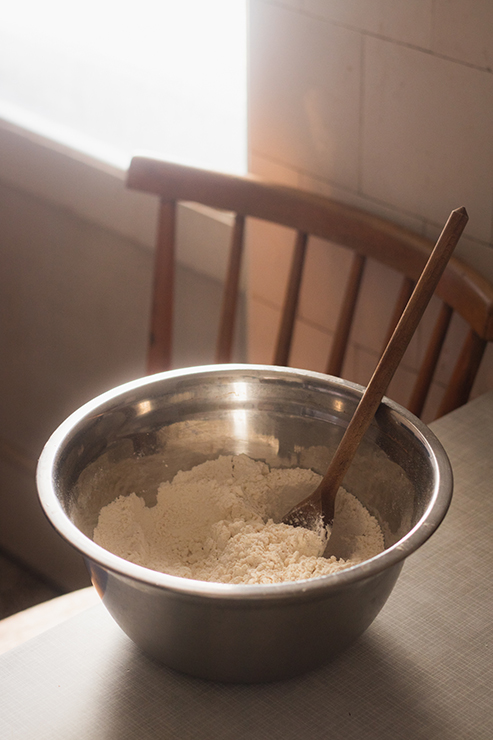
The only “trick” in this recipe is to use boiling water. It will immediately soften the dough and make it possible to mix and knead to get a smooth texture even with as little water as 1/3 of the flour volume.
This would not be possible with cold water, and you would risk having the cooked pasta turn a bit mushy. Using hot water will give you dough that is easy to work with, and perfectly compact noodles that don’t fall apart.

When you pour the boiling water into the bowl with flour, don’t get discouraged if it looks a bit dry at first. It WILL combine, just be patient and don’t add any extra water. As soon as you can touch the dough with your hands, you can start kneading it and you will soon get a nice and smooth texture.


Once the dough is well kneaded, you can wrap it well in a waxed cloth or a plastic bag to keep it from losing moisture and drying out. Let it sit at room temperature for 20-30 minutes to cool down, and then put it in the fridge for at least an hour.
I like to make mine in advance and let it cool down in the fridge overnight. That way it will be really easy to work with, and you will be able to roll it out as thin as you like. If you are short on time, it is also possible to make noodles from freshly made dough. It might still be a bit soft and sticky though, so I recommend letting it cool down at least a bit.
How to make spelt pasta without any fancy kitchen equipment
This recipe does not require any special kitchen tools. If you have a pasta maker – great, you can use it to get nice and thin noodles without much hassle. But if you don’t, it is not a problem at all. You can simply roll the dough out with a rolling pin.
Honestly, I love to make spelt noodles without a pasta maker even though I have one at home. I like the feeling of making everything by hand. Also, there is space for improvisation even if you don’t have a rolling pin handy.
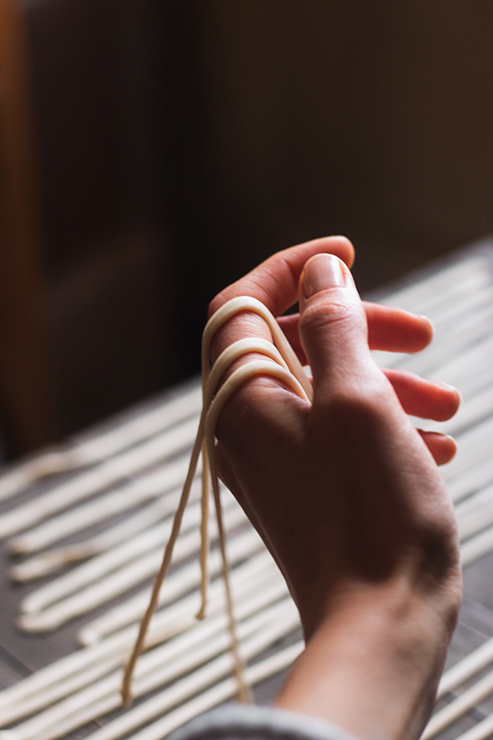
There were many occasions on which I would hold a pasta-making workshop with more people enrolled than planned; sometimes the organisers wouldn’t be able to supply us with that many rolling pins, so we would have to improvise and use any cone-shaped thing we could find, such as glass bottles, to roll out the dough.
It would always turn out great, and my students loved it because they got to see that it is possible to make pasta even without some of the most basic kitchen equipment. Essentially, you will only need a bowl, a pot and a spoon and you are good to go.
Cutting the noodles
I like to cut the flattened dough into noodles without any extra steps – I just lay it on a large wooden board and cut it straight with a sharp knife.
If you don’t have that much space, you can also follow these simple steps:
- Roll out the dough to a desired thickness
- Let it air-dry for a couple of minutes
- Dust it with some spelt flour
- Roll it loosely as if it were a giant pancake
- Cut the rolled dough into “slices” (each slice will be a noodle when unwrapped).
Both ways to cut the noodles are good, but I prefer cutting them from a straight piece of flattened dough. Even though it takes a bit longer, the noodles will turn out tidier this way – at least from my experience with this particular dough recipe.
Cooking and storing homemade pasta

Freshly made noodles can be cooked right away – just put them in a pot with boiling water and cook over medium heat until all the noodles float to the surface. This usually doesn’t take longer than a couple of minutes.

If you decide to store the noodles for later, you can either freeze or dry them.
To freeze the fresh noodles, let them dry for about half an hour at room temperature and dust well with spelt flour to avoid sticking. Put them in a container (gently, without any pressing) and store them in a freezer.
Drying the homemade noodles is probably the most practical option for storing them. Let the fresh noodles dry at room temperature until they are dry enough to handle without sticking to one another, but still soft enough to shape without breaking. Shape them into small “nests” and let them dry completely.
Alternatively, you can let the noodles dry fully in their original form (straight) and store them like that. The “nests” are a bit more practical because it is easier to avoid breaking the dried pasta, and they can be kept in any kind of container, such as a glass jar.
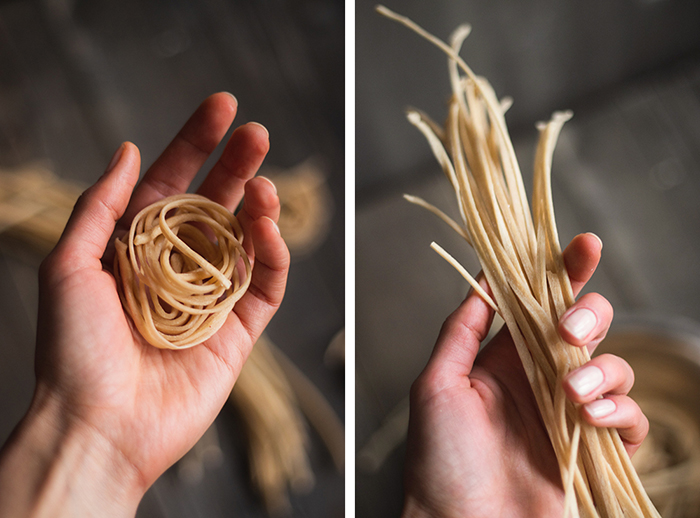
Useful equipment for homemade spelt pasta
To make spelt pasta at home, you will need the following equipment:
- large mixing bowl for combining all the ingredients
- cooking spoon for mixing when it’s still hot
- rolling pin for flattening the dough
- large cutting board and a knife for cutting the flattened dough into noodles
- cooking pot for cooking the homemade pasta
- large glass jars for storing dried pasta (if you decide to dry it)
- reusable freezer bags for storing the pasta in the freezer
- pasta maker – optional, but fun and useful if you make pasta regularly. I use a manual pasta maker like this one, but there are also pasta machine attachments like this one for an electric mixer (I haven’t tried it yet, but my friends adore it), that make the pasta-making process even easier.
Homemade Spelt Flour Noodles (Vegan, Without Pasta Maker)

Two-ingredient vegan spelt flour noodles that can be made at home, without using pasta maker machine.
Ingredients
- 3 cups spelt flour*
- 3 pinches Himalayan or sea salt
- 1 cup water
Instructions
- Bring a cup of water to a boil.
- In a bowl, mix three cups of spelt flour with three pinches of salt.
- Pour the boiling water into the bowl with flour, and mix with a wooden spoon.
- Keep on mixing with the spoon to combine; it might seem like there is too much flour at this stage, but don't get tempted to add more water. It will combine into a nice and smooth dough as you continue mixing it.
- Once the mixture is no longer too hot to touch with hands, start kneading it to get a smooth dough.
- After you have kneaded it well with your hands, wrap the dough in a plastic bag or a beeswax food wrap (something that will prevent it from losing moisture) and set it aside.
- Let the dough cool down at room temperature for about half an hour, and then transfer it to the fridge. Keep it in the fridge for at least an hour, or even better, overnight.*
- Roll out the dough with a rolling pin. It should be quite thin; I like to roll it out to around 1 mm (0,04 inches), but you can also go for a little bit thicker before you get some practice (or if you simply like thicker noodles).
- Cut the dough into noodles with a sharp knife. I like to do it just like that - by simply cutting the flattened dough into straight strips. Alternatively, you can dust the flattened dough with some spelt flour, roll it into a loose roll and cut that roll into slices = noodles.
- Let the noodles dry on a kitchen cloth or a wooden board for 10-15 minutes to avoid having them stick to one another.
- To cook the freshly made noodles, just put them in a pot filled with boiling water, and cook over medium heat for up to a couple of minutes - when you see that all the noodles have floated to the surface, it means they are cooked.
- If you would like to save the noodles and cook them on some other occasion, you can either freeze the noodles after letting them dry for 15-30 minutes (and dusting them well with some spelt flour to avoid sticking), or let them dry completely and store in a jar.*
Notes
* My favourite flour to use in this recipe is white spelt flour type 630, but it will work equally well with whole grain spelt flour. If you are using whole grain flour, try to get as finely milled one as you can.
* I like to make the dough for pasta a day ahead so that it can properly cool down in the fridge. This way it gets a bit harder and can be rolled out really thin without breaking or sticking to the working surface. If you haven't planned ahead, don't worry. It can be used as soon as half an hour after you have finished kneading it. It might be a little bit harder to make thin noodles that way, but it will work nonetheless.
* Making pasta without a pasta maker machine is easy, but if you make pasta regularly and want to make it even easier - I recommend a manual pasta maker machine like this one. I have it at home and enjoy using it - it helps a lot with getting nice-looking noodles with a consistent thickness.

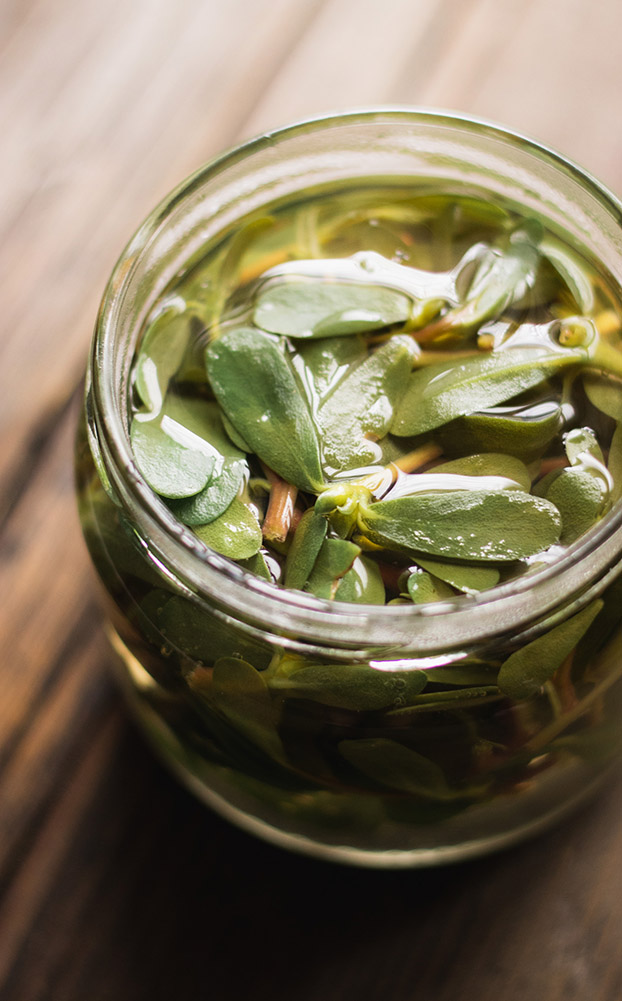


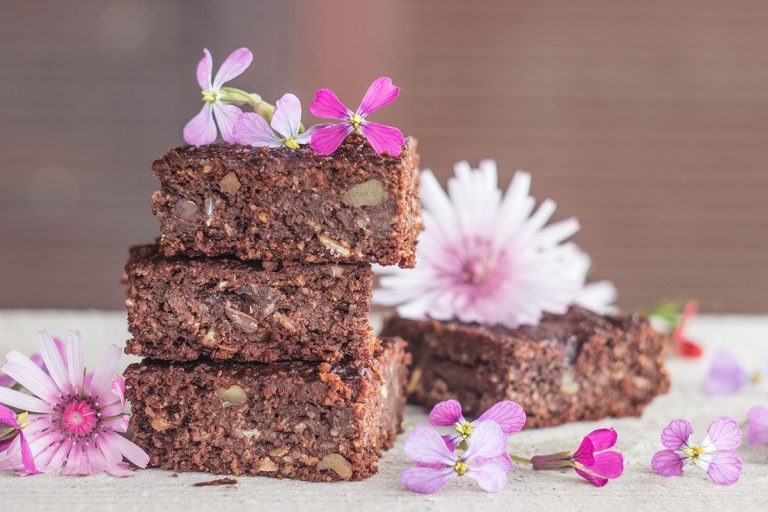


Either I missed it or it was left out, the most important part – how to cut the dough into noodles?
Hi, thank you for the comment! I just cut the flattened dough into strips with a knife. Dusting the flattened dough with some flour and rolling it loosely (like a pancake) before cutting is also a cool option – then you just slice that roll and unwrap the slices into noodles. This is useful if you don’t have a large cutting board to just cut the flat dough.. I added this step to the recipe, thanks for noticing that it wasn’t written. Hope you’ll enjoy making the noodles 🙂
Can I make these with SPROUTED spelt flour?
Hi Susan! It will be difficult to make a compact dough that does not fall apart from sprouted spelt flour. I never tried this recipe with sprouted spelt, but if I were to do it, I would use some flax meal to bind it. I would try and add a tablespoon or two of flax meal to the dry ingredients. It might be a bit more sticky than the original, but sounds possible. If I try it out any time soon, I will definitely let you know! And if you try it, I would love to hear how it went 🙂
Thank you so much. I just ground some whole spelt (I make sprouted spelt bread) into flour in my Vitamix. Hard to tell how fine it is. I followed your recipe but found two things:
1) with this spelt flour I needed more boiling water, for sure.
2) When cooking, the noodles float to the top of the boiling water almost immediately. I’m not a homemade pasta expert but they tasted raw.
Also, how thick/thin is something I need to learn. I started browsing pasta rollers on line!
Anyway, I am going to make this work. It takes learning and patience and practice like anything else.
Thank you, it’s still genius.
Thank you so much for sharing your experience and impressions! Good to know this about homemade spelt flour. Maybe they were a bit lighter because of all the bran and started floating a bit earlier. If it is impossible to tell if they are ready because they float immediately, about three minutes should be enough to cook fresh noodles if they are not very thick.
Honestly, a pasta roller makes life so much easier! Here I wanted to keep it simple and show that anyone can make pasta, but pasta roller brings it to another level 😀
Thanks again for sharing, I appreciate it! Good luck with the next batches, I’m sure they will turn out great 🙂
Also, I didn’t mix or knead but instead I used a kitchenaid mixer with, first, a paddle blade and, second, the dough hook. Works fine.
Second batch (I tried cooking a little at a time) I rolled thinner. Much better.